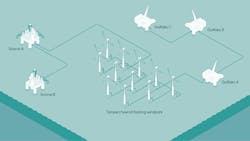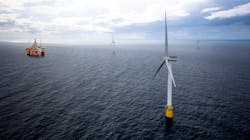Floating wind turbines to power North Sea Gullfaks, Snorre platforms
Norway’s government has been pushing hard for ‘cleaner’ power to cut emissions from the country’s offshore field centers. Various operators have responded, with more schemes being tabled to import electricity directly from the shore through subsea power cables. Most of the projects either completed or in progress are for fields in the North Sea: the scope is becoming increasingly ambitious, with the Utsira High Power Grid set to bring power from the mainland to five field centers in the central Norwegian North Sea.
However, there are technical constraints such as distance from the shore and potential stresses on Norway’s grid with so many competing projects. For the Gullfaks and Snorre field complexes in Tampen area of the northern North Sea, Equinor and its partners have chosen an alternative approach, commissioning the world’s first floating offshore wind park designed specifically for powering oil and gas platforms. The 11 Siemens Gamesa wind turbines, supported by concrete hulls constructed by Aker Solutions, will be moored at a location 140 km (87 mi) offshore where winds are reliably stronger, in between the two field centers, in water depths of up to 300 m (984 ft). The turbines will collectively supply 88 MW of power to the five platforms, representing around 35% of the two fields’ needs.
This will offset some of the power currently provided by the platforms’ gas turbines. Use of these turbines will be scaled back, cutting annual CO2 emissions from the two fields by around 200,000 metric tons (220,462 tons), and nitrogen-oxide emissions by 1,000 metric tons (1,102 tons).
The 11 Siemens Gamesa 8.0-167 DD wind turbines will feature a High Wind Ride Through (HWRT) system. When the wind speed is above 25 m/s (82 ft/s), wind turbines will typically shut down for self-protection. With the HWRT, however, the turbines slowly ramp down output power, leading to a smoother production rampdown and therefore a more reliable electrical grid.
Each of the floating wind turbines will be held in place by three mooring lines, connected to the seafloor via suction anchors. Under a joint venture, Aker Solutions and DOF Subsea are due to complete all assembly/offshore installations by summer 2022. JDR Cable Systems is responsible for design and manufacture of the 66-kV dynamic inter-array cables and the static and export cables (including breakaway systems) between the wind park and the two field centers. For Hywind Tampen, one of the main anticipated challenges is the dynamic stresses the cables will need to withstand in the Tampen area.
The 2.5-km (1.55-mi) long dynamic array cables will connect to the 11 turbines in a loop, while the two static 12.9 km (8-mi) and 16-km (9.9-mi) export cables will link the loop to the Snorre A and Gullfaks A platforms.
Platform upgrades
Wood is responsible for integration of the wind turbines to the platforms and for the onshore control room in Bergen. The work scope includes design, integration, and delivery of Employer SCADA and telecommunications systems to be installed in the wind turbines, and modifications to the power management system on Snorre and Gullfaks to ensure an optimized design using the wind power. Wood is also managing required topsides modifications on the Snorre and Gullfaks platforms and the onshore control room, performing engineering, procurement, fabrication, and installation.
According to Bjørn Kingestad, senior project manager at Wood, “The existing power management system (PMS) functionality on Snorre and Gullfaks will be upgraded to receive power from the wind farm. Electrical power system studies are being conducted to ensure that the electrical grid on Snorre and Gullfaks can integrate the new power source from Hywind Tampen. The work includes investigating dynamic challenges regarding power flow and capability when starting, running and disconnecting large electrical consumers and generators.
“The most central function for the PMS is to ensure a safe and predictable operation of the hybrid power system, capable of receiving both wind and gas turbine-generated power. The PMS will also ensure maximized use of wind power to minimized fuel gas usage and CO2 emissions. The introduction of wind power will not have a negative impact on the reliability/regularity of power supply on the platforms. If the wind park needs to be shut down, due, for instance, to an extreme weather event, power could be maintained on the platforms via the existing gas turbines which act as a back-up power source.”
The floating wind turbines will be connected to both Gullfaks and Snorre in a ring solution. Normally, five floating wind turbines will be connected to Gullfaks, and six to Snorre. The design will also accommodate other set-ups. “Structural changes are mainly related to the topsides modifications on Snorre A and Gullfaks A. As for the existing control rooms, the main tasks are modifying and creating new Human Machine Interface (HMI) operator displays used for supervision and operation of the system from the control room screens. Vysus Group is supporting Wood with the Human Factors (HF) scope, while Goodtech is supplying the Employer SCADA system.”
Wood has performed Human Factors analysis and staged workshops, he added, to provide input to the modification and new HMI layout and graphics display design, including a new alarm/signal feature, and the layout design of the wind farm control room. The company is managing the engineering/design work from its offices in Stavanger, Bergen and Sandefjord, where necessary, using resources from other parts of the group.
According to Mats Wang, Human Factors Consultant at Vysus Group, “it’s important to get the right balance between automation and human interactions in the systems, and to ensure that the control room operators have the information that they really need and not too much or too little. The human factors analysis takes into account the new tasks and functions required and the risks associated with the level of automation built into Hywind Tampen.”
“Over the past year the team has spent much time working from home due to COVID-19 restrictions,” Kingestad explained. “As both the Wood and Equinor project teams are split between different locations, working from home and co-operation via digital platforms has been working beyond expectations. We have had the same experience with our interfacing contractors on the Hywind Tampen project, these being split between different locations in Europe. However, our team has made site visits and plans more visits to the platforms and to the onshore control room, as permitted by safety and travel restrictions.”






